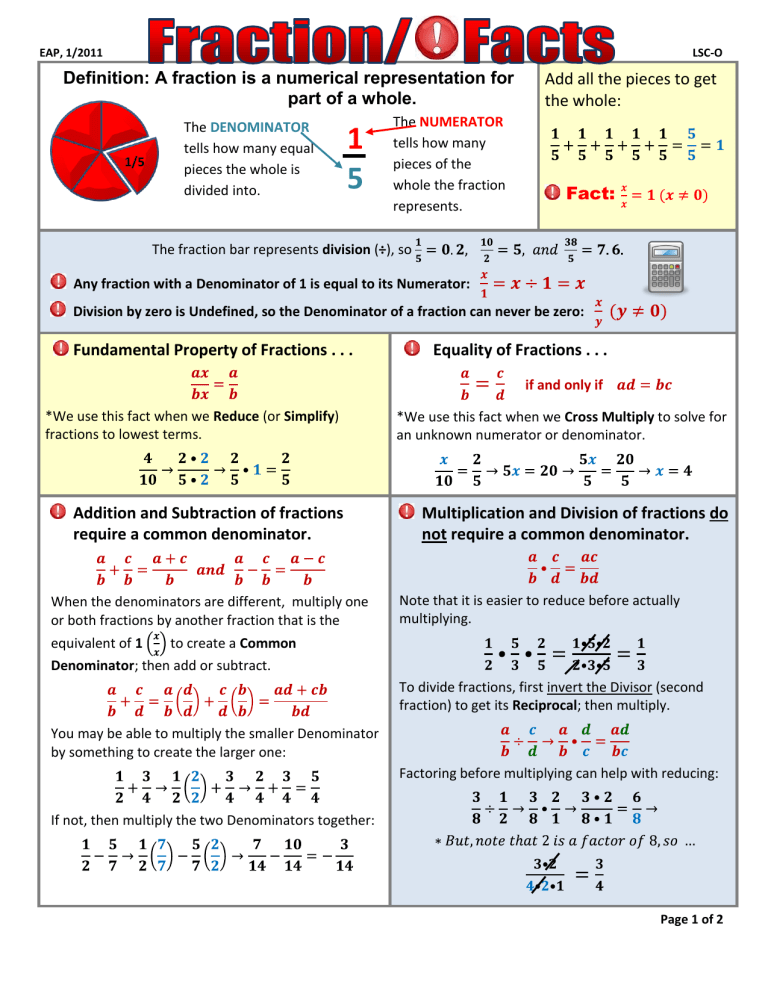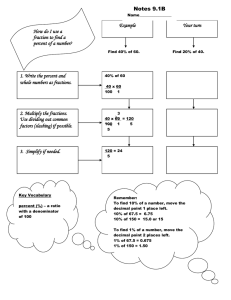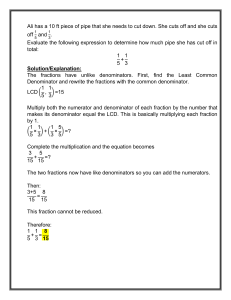
EAP, 1/2011 LSC-O Definition: A fraction is a numerical representation for part of a whole. 1/5 The DENOMINATOR tells how many equal pieces the whole is divided into. 1 5 The NUMERATOR tells how many pieces of the whole the fraction represents. Add all the pieces to get the whole: Fact: The fraction bar represents division (÷), so Any fraction with a Denominator of 1 is equal to its Numerator: Division by zero is Undefined, so the Denominator of a fraction can never be zero: Fundamental Property of Fractions . . . Equality of Fractions . . . if and only if *We use this fact when we Reduce (or Simplify) fractions to lowest terms. *We use this fact when we Cross Multiply to solve for an unknown numerator or denominator. Addition and Subtraction of fractions require a common denominator. Multiplication and Division of fractions do not require a common denominator. When the denominators are different, multiply one or both fractions by another fraction that is the Note that it is easier to reduce before actually multiplying. equivalent of 1 to create a Common Denominator; then add or subtract. To divide fractions, first invert the Divisor (second fraction) to get its Reciprocal; then multiply. You may be able to multiply the smaller Denominator by something to create the larger one: Factoring before multiplying can help with reducing: If not, then multiply the two Denominators together: Page 1 of 2 EAP, 1/2011 LSC-O A Proper Fraction has a numerator that is smaller than its denominator and represents a quantity less than the whole, or < 1: An Improper Fraction has a numerator larger than its denominator and represents a quantity greater than the whole, or > 1: 1/5, 2/5, 3/5, and 4/5 are proper fractions. 6/5, 10/5, and 27/5 are improper. Mixed numbers, such as together. are whole numbers and portions less than 1 (fractions) added It is often useful in doing calculations to convert mixed numbers to improper fractions. To do so, change the whole number to a fraction with the same denominator as the other fraction and add: A quick way: (WHOLE NUMBER X DENOMINATOR + NUMERATOR)/DENOMINATOR: To go from improper fraction to mixed number, simply divide the Numerator by the Denominator. The Remainder over the Divisor is the fractional portion. Comparing fractions . . . 7 → 7 3/5 5 )38 35 3 Eliminating fractions . . . Obviously 5/8 > 3/8, but what about 5/8 and 7/12? Here’s how to tell: A fraction multiplied by its Reciprocal equals 1; use this fact to isolate x and solve an equation: Express each fraction with a Common Denominator: Or, express each as a decimal: Also, test for Equality of Fractions Multiply through by the Least Common Multiple (LCM) of the denominators replaces fractions with whole numbers, making an equation easier to work with: : From Decimals to Fractions to Percents . . . Decimals can be expressed as fractions with a Denominator that is a Power of 10. The number of digits behind the decimal tells how many zeros belong in the denominator. Remember to reduce fractions when possible: To express a fraction as a percent, first divide the Numerator by the Denominator; then multiply the resulting decimal number by 100 (or, simply move the decimal two places to the right): 1/2 = .50 = 50%, 1/4 = .25 = 25%, 9/40 = .225 = 22.5%, and 1/1 = 1.00 = 100% Page 2 of 2



